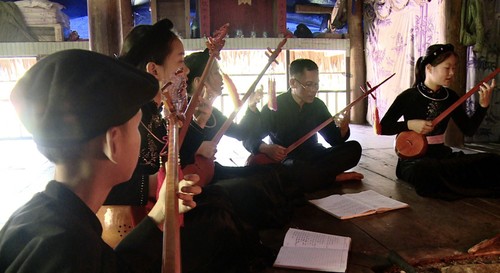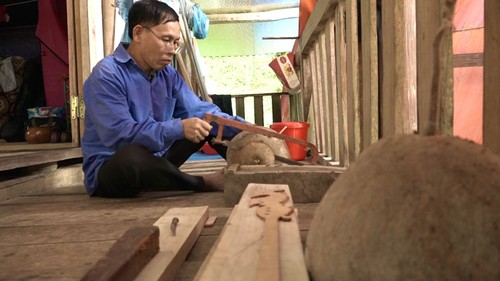 Students of artisan Hoang Lien Son. (Photo: Ngoc Mai/VOV5) Students of artisan Hoang Lien Son. (Photo: Ngoc Mai/VOV5) |
Then Master Hoang Lien Son has taught his Then singing classes for more than 20 years.
Then singing, which combines singing, dancing, and playing musical instruments, is popular in the northern mountain provinces of Cao Bang, Bac Kan, Lang Son, Tuyen Quang, and Ha Giang. It is normally performed at village festivals or on special occasions such as New Year celebrations, weddings, and ceremonies to expel evil.
When Son opened his first free class, few people thought it would last long. Son was determined to continue, however, and has never doubted that he was on the right course.
"I opened free Then singing classes because I want to preserve the culture of the Tay people and pass it on to the next generation,” said Son.
”My students range from 9-year-olds to 50-year-olds. I want people to understand that Then is accessible to everyone. It’s close to people’s lives and everyone is welcome to learn it. The melody of Then singing is suitable for people of all ages, and to me, each Then artist is a living treasure of folk art.”
 Artisan Hoang Lien Son and his students. (Photo: Ngoc Mai/VOV5) Artisan Hoang Lien Son and his students. (Photo: Ngoc Mai/VOV5) |
“Then” literally means “thien” – heaven. Then singing is equated with fairy singing and Then singers are thought to be messengers of God and able to deliver people’s wishes to God. That’s why Then singers perform at ceremonies to pray for peace or a bumper crop or to summon a spirit from Heaven. In addition to local ethnic minority people, Son’s class sometimes includes foreigners.
"Since a majority of my students are children or teenagers, I often hold the classes in the summer time. We welcome foreign tourists who are interested in learning Then singing because we want to introduce and promote our traditional culture to a wider group of people", Son said.
The practice of Then ritual, which has been recognized by UNESCO as an Intangible Cultural Heritage of Humanity, is considered a way to help people overcome life difficulties, promote a moral lifestyle, and preserve the customs of ethnic minority communities.
 Artisan Hoang Lien Son makes the Tinh lute. (Photo: Ngoc Mai/VOV5) Artisan Hoang Lien Son makes the Tinh lute. (Photo: Ngoc Mai/VOV5) |
Local people have a saying: “Then singing is a gift that the Tay people have been endowed with, but Then without a gourd lute is like spring without peach blossoms”. The Dan Tinh, also called the Tinh Tau in Vietnamese, is a stringed musical instrument associated with Then singing. Son’s classes not only teach Then singing, but also the process of making the Tinh, the gourd lutes.
"I learned how to make the Tinh lutes and have been doing it for more than 40 years. It must be crafted so that the timbre of the lute is the same as in the old days. In order to produce clear, warm Then melodies, the gourd lute is a particularly important factor,” Son said.
“The lute usually has 2 or 3 strings and is often accompanied by a woodwind instrument, such as a bamboo flute. Teaching people to make gourd lutes is as important as preserving Then singing."
Then singing is starting to die out. Seeing this, Son has become obsessed with preserving it and passing on his passion to younger people. In addition to teaching Then singing at his house and at many art clubs, he has rewritten some traditional Then melodies to make them more relatable to modern society. And his effort has paid dividends.
Here are some opinions of students at Son's classes:
“Before, I didn't know anything about Then singing. After one year of being taught by Mr. Son, I’m able to sing some basic tunes and have become more interested in Then singing.”
“I really love the melodies of Then singing. Living in a mountainous area, we can’t afford to pay for lessons like this. But fortunately we have Son's free class to teach us Then singing and our cultural tradition.”
“I study at a boarding school. Every time I come back home, I attend Son's class to meet friends and learn more about Then singing.”